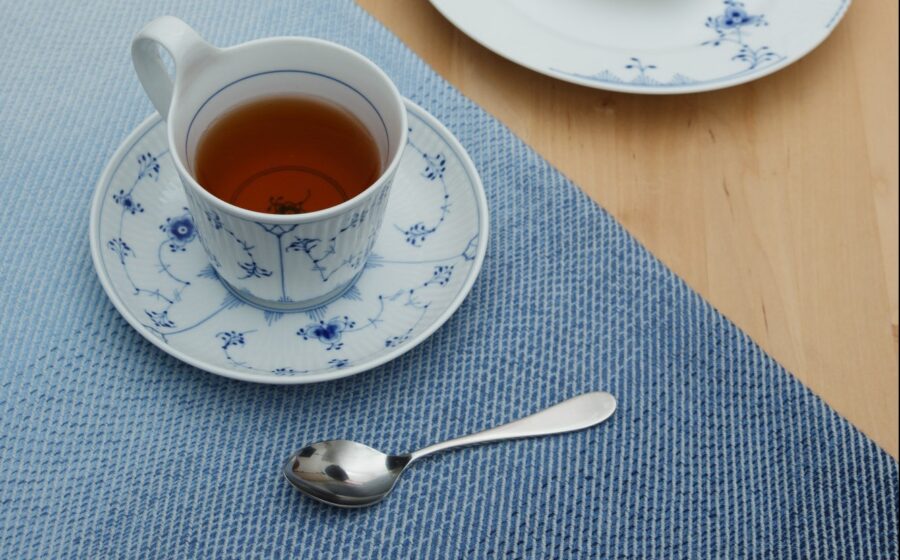This is a reprint of an article originally published in 2006. Read Richardson’s follow-up piece on the current state of tea in Britain here.
[W]hat is happening to the British national beverage? Tea may have been an essential element of British society for 300 years, but the nation’s love affair with their traditional brew is showing signs of restlessness.
No commodity is more inherent to the image of Britain than tea. This caricature is so ingrained in the American mind that many people often assume that I, as a tea blender, procure all my teas from London. That would have been the case years ago, but Britain’s influence in the world tea market has diminished and the once dominant industry now scurries to find its place. They must put on a fresh new face that will compete in a market becoming more and more crowded with emerging stars in the world of tea.
Writer Elizabeth Knight loves to recall an encounter she had with the tea buyer for Fortnum & Mason. His comment was, “Tea is like wallpaper in Britain. It is my Fortnum & Mason, London job to introduce our customers to beautiful and rare teas that they would not otherwise encounter.” That is indeed the image that British marketers are trying to shake. To the younger set, tea is the preferred beverage of their grandmother, or it’s something your mum gives you when you are feeling under the weather. It is a common staple as ubiquitous as wallpaper.
Those grandmothers are one of the bright spot in the sales of traditional tea bags. Customers aged fifty-five to sixty-four are loyal tea drinkers, and this demographic continues to grow with an aging population; 55 percent of this market has a favorite brand that they drink regularly.
I’ve seen evidence of this loyalty for years, mainly to brands such as Typhoo and PG Tips. British customers who visited the tea room I once owned were devoted to these brands—to them, they were mother’s milk. One visiting English family had a hard time making a decision from the fifty or so teas I listed on my tea menu; after several weeks of traveling in the United States, the box of PG Tips they’d brought from home had been exhausted two days prior. They were ecstatic when I presented them with an unopened sample box that had been gathering dust in my pantry. That small gift ensured their happiness and the success of their final few days of holiday in America.
But, the future of the British tea industry cannot be sustained by its seniors or low-cost tea bags. The decline in sales for the traditional British tea market was 9.5 percent from 2002 to 2003. Market consultants point to the rise of coffee, bottled water, and health drinks that have cut deeply into the consumer base once dominated by hot tea. American-style coffee shops are found on nearly every block in London. Commuters clutching sleeved cups of Starbucks coffee are as common on Bond Street as they are on Wall Street.
Several turns in England’s recent tea history have been significant. In 1998, the tea world took note of England’s decreasing dominance as three centuries of tradition came to an end with the conclusion of London’s last tea auction. Since the time of Elizabeth I and the domination of the East India Company, tea had been the commodity that ruled the empire.
More recently, the 100-year-old Typhoo Tea brand was sold to the Appejay Surrendra Group in India. This buyout comes on the heels of Tata Teas’ 2001 acquisition of Tetley. Two of five best-selling English teas are now owned by Indian companies.
American tourists enjoying afternoon tea in some of London’s most fashionable venues will soon see familiar brands on the tea table. Harney and Sons Fine Teas is now the house tea at the Dorchester Hotel at Hyde Park. The hotel’s palatial Palm Court has for years been one of the top afternoon tea settings in the world. Another landmark hotel, the Savoy, has turned to Canada’s Metropolitan Tea Company as their tea supplier. Even the retail giant Harvey Nichols has added artisan teas from Numi Teas in their café and tearoom in Knightsbridge.
The British Tea Council embarked several years ago on a campaign to promote a young and contemporary image of tea. Their emphasis has been to promote celebrities drinking tea, emphasize tea’s health benefits, and recognize tea retailers who serve outstanding tea. Executive director Bill Gorman insisted his own reading of the tea leaves did not forecast doom for the tea industry. He says the growth in specialty teas was making up for any decline in the traditional brew. “On average, every person in Britain still drinks three cups of tea a day,” he said.
One recent winner of the Tea Council’s Top Tea Room award was the Bird on the Rock Tea Rooms in Shropshire. Located west of Birmingham and near the Welsh border, this rural tearoom offers an extensive list of well-chosen teas, both single-estate and blends. More than a dozen international magazines and newspapers have written about their success and they have built a devoted clientele. Tearooms and tea shops across the isles are taking note, and many have followed suit by expanding their offerings to include more than the standard Earl Grey and English breakfast teas.
In southwest England, Jonathon Jones, head gardener of the Tregothnan estate near Truro in Cornwall, concluded that tea bushes would do well on the estate known for its flowering camellias. The conditions are not unlike the cool and rainy uplands of parts of mountains of Darjeeling. He planted 500 bushes five years ago and debuted his first harvest in the fall of 2005 at a London media event. Steep production costs and low yield will keep the price high but, for the moment, this story has brought interest and a bit of pride to the English tea scene.
The stars of the London retail tea scene show encouraging evidence of the future of British tea. Of course, Harrods and Fortnum & Mason continue to stock their tea bars with rare single-estate and blended teas from top gardens. They have long been leaders in the move toward gourmet teas.
The newest tearoom making a splash is the Tea Palace in Notting Hill. This chic, bright tea house attracts thirty- to forty-five-year-olds in search of a calm oasis in one of London’s most fashionable neighborhoods. Nearly half the space is devoted to shelving 150 tea canisters. It is one of the best presentations of tea in England.
One of the best places to enjoy a cup of white or oolong tea (and maybe a sighting of a celebrity) is the Lounge at Sketch on Conduit Street. This trendy restaurant serves well-prepared teas in the relaxed boutique setting of their lounge. If a full afternoon tea is more your liking, the Hotel Berkeley serves one of the most creative and refined teas in London. They are masters at pairing tea and beautiful foods for a memorable experience.
What changes are the major packers making? Twinings and Jacksons of Piccadilly appear to be the most successful in moving toward green tea. They accounted for 60 percent of Britain’s green tea sales in 2004. Twinings added several flavored teas, including strawberry, mango, and apple cinnamon.
England is taking note of America’s newfound love affair with tea. Fueled by the popularity of green tea, white tea, and herbal blends, American tea consumption is being driven by a health-conscious consumer base. Marketing tea as a gourmet product might be easier to accomplish on the American tea scene because there is no preconceived notion of what tea can or cannot be. Flavored teas have been popular here for two decades. Like flavored wines, flavoring was the “hook” that brought many consumers into the new market. Tea drinkers who entered the world of tea because of flavorings tend to investigate other varieties as their tastes evolve. Britain’s brand loyalty, and the custom of adding milk to tea, may have stymied their desire to sample non-traditional brews.
The British tea industry’s challenge now is to reach younger consumers by making tea more fashionable and contemporary. It needs to blow the dust off their tea image. Herbal and fruit infusions, which have the greatest appeal among twenty-five- to forty-four-year-olds, will help bolster consumption among a younger demographic. The British may do well to follow America’s pace in encouraging new tea drinkers. After all, old wallpaper, as beautiful as it might have been, still needs freshening now and then.
—Bruce Richardson is the owner of Elmwood Inn Fine Teas and the author of such books as the Great Tea Rooms of Britain and the New Tea Companion.















